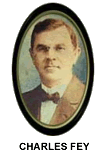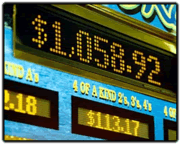History of the Slot Machine
History of slots
The first slot machines were called “one-armed bandits,” machines in which you put your money and pulled the handle. Sometimes symbols lined up and gave you a win, but most often the machine left you penniless, hence the name. Modern slot machines are modernized versions of those machines.
 Charles Fey, a German immigrant, invented the first slot machine around 1897. He called it “The Liberty Bell” because of the symbols he put on the jackpot-winning line. Other popular symbols were the face cards from a card deck and horseshoes.
Charles Fey, a German immigrant, invented the first slot machine around 1897. He called it “The Liberty Bell” because of the symbols he put on the jackpot-winning line. Other popular symbols were the face cards from a card deck and horseshoes.
By 1899, “Sittman and Pitt of Brooklyn” had emerged as a rival to Fey, taking his three-line slot machine and expanding it to five drum payline machine. Their new version had 50 card faces, and winnings were based on poker hands: pairs, straights, flushes, and royal flushes. The bar owners themselves determined each machine’s pay table. A beer might be awarded for a good pair; tobacco, cigars, and other items might be the reward for a flush or a royal flush.
Some bar owners went so far as to remove the ten of spaces and the jack of hearts from the set of symbols, thereby cutting the chances of getting a royal flush in half and increasing their profit by this dirty trick. That same act today would get the owner a solid jail sentence, which he would deserve.
Gambling and one-armed bandits were outlawed in 1902, but slot machines were so popular that many were converted into games that awarded candy, drinks, and gum rather than money. The symbols on them changed into pictures of the fruit slots that we still see today. Images of sticks of gum became the 1, 2, and 3 bars that we see today.
Even after the prohibition against gambling ended, it wasn’t until 1964 that slots started to regain their full popularity. In that year, Bally developed the first fully electronically controlled slot machine called “Money Honey.” They used their knowledge of the popular pinball machines that they manufactured to develop slot machines that were more random, had more reels, and had large hoppers – which allowed them to offer bigger payoffs.
Starting in 1980, the invention of the random number generator (RNG) allowed slot machines to be even more random, and the number of slot machines in casinos exploded. Las Vegas style jumbo slots allowed millions of possible outcomes. These new slot machines incorporated computers into their workings, replacing the old cogs and wheels, and that allowed casino owners greater control over payoffs, money, and images.
 If a punter from the 1900’s found himself in Las Vegas today, he might very well think that aliens had landed. Slot machines continue to change their features, graphics, and jackpots. One thing remains constant, though: the machines are there to take your money. Don’t forget that the house edge on slots is higher than any other game, and almost 70% of modern casino profits come from these descendants of the “one armed-bandit.”
If a punter from the 1900’s found himself in Las Vegas today, he might very well think that aliens had landed. Slot machines continue to change their features, graphics, and jackpots. One thing remains constant, though: the machines are there to take your money. Don’t forget that the house edge on slots is higher than any other game, and almost 70% of modern casino profits come from these descendants of the “one armed-bandit.”
Punters and gamblers still keep the game popular, hoping to score one of those mega-wins from Vegas. It would be fantastic to hit such a big win, but bear in mind the reality! Slots should only be played for fun, and not for profit. The ideal way is to put aside a certain amount of your bankroll, and just spend that portion on slots. If you win, great! If you don’t, just move on.
People say that the lottery is pointless, and the odds are tremendously stacked against you (at about 50,000,000 to 1) but someone manages to win it every week. Maybe with slot machines, that lucky winner will be you!
Slots Hints & Tips | Slot Machine Strategies | History of Slot Machines | How to play Slots
| Progressive Slots |
LINK TO THIS PAGE: